NFTs for Podcasters: FULL Guide to Audio NFTs & Whether You Should!
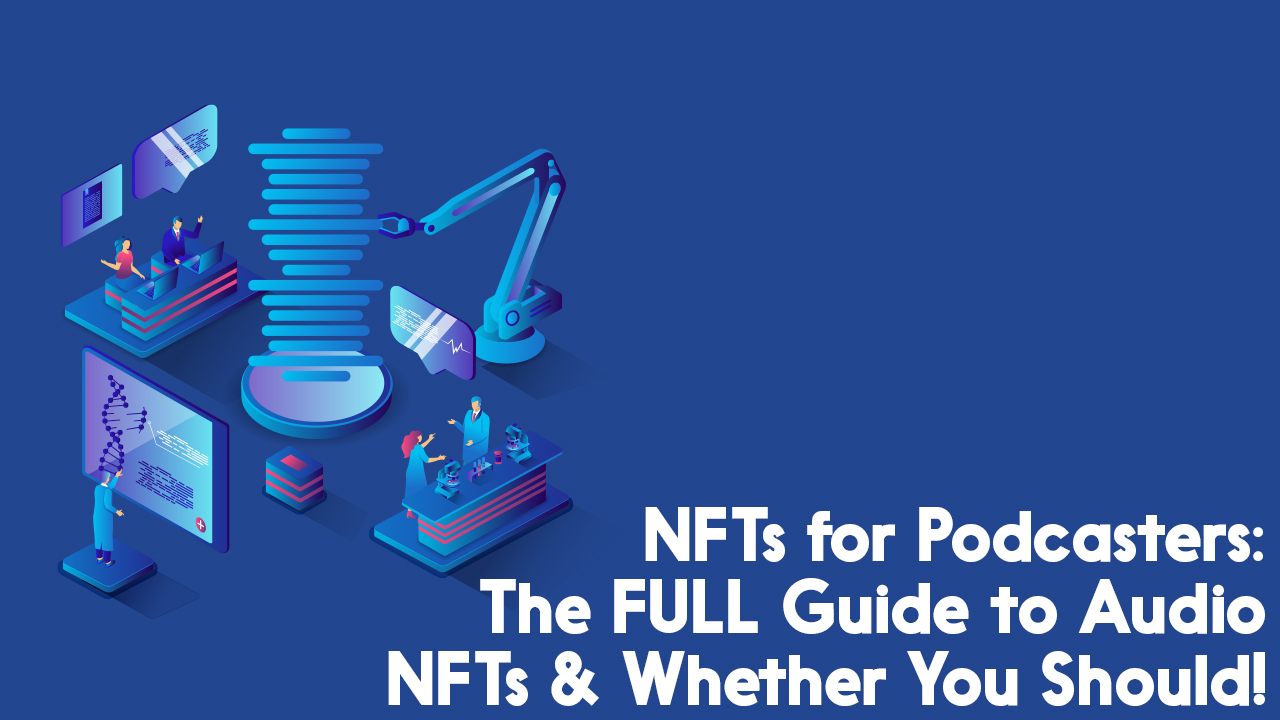
I remember the first time I heard the term NFT. It was about a year ago, listening to Kevin Rose’s ever-excellent podcast (The Kevin Rose Show). I’m not sure why this sticks in my head, but I was about to take a run into one of the endless, stunning, dust-filled creeks right outside Adelaide, South Australia. That soon-to-be-everywhere acronym popped out of his mouth, into my ears, and kickstarted a whole chain of events for me.
But, right then, all I was left thinking was: What is an NFT? What do NFTs mean for podcasting? And what is that Koala bear doing peeing on my car?
Here’s a short answer, for you, my dear podcaster:
I’d parked under the wrong tree 🐨
And, here’s another one:
NFTs could be a way to engage your audience, offer them more value and earn from your podcast. All by creating unique audio and visual assets which you can sell and use as a tool in your community. But there are a LOT of caveats, right now…
What are those assets, you ask? Weird cartoon monkeys with a motivation problem? Characters from the video games you played in the 90s? Well, maybe. But, being in audio, we can get much more creative.
And why might you use NFTs, rather than selling a standard product, or a membership? The really interesting aspect is that these things might let your audience take part in your success, and can encourage them to help you grow. It could be a really compelling way to build a community.
But, there are a lot of questions. A LOT. Everything from the environmental impact to financial risk, to questions around inequality. I and our team learned some of them the hard way when we ran a little experiment around this early 2022 (more on that below! 😅). So, is it a good idea?
That depends… as always!
Let’s find out what NFTs are all about, what podcasters might be able to do with them, and what to be wary of.
What’s an NFT? The 1 Minute Breakdown
Okay, the basics: NFT stands for non-fungible token.
But that doesn’t really help, does it? What’s fungible? What does it mean when you aren’t fungible? Sounds like a mushroom of some sort, so maybe it’s not good to be fungible…? I mean, sometimes I like to sit in a dark room for hours, but…
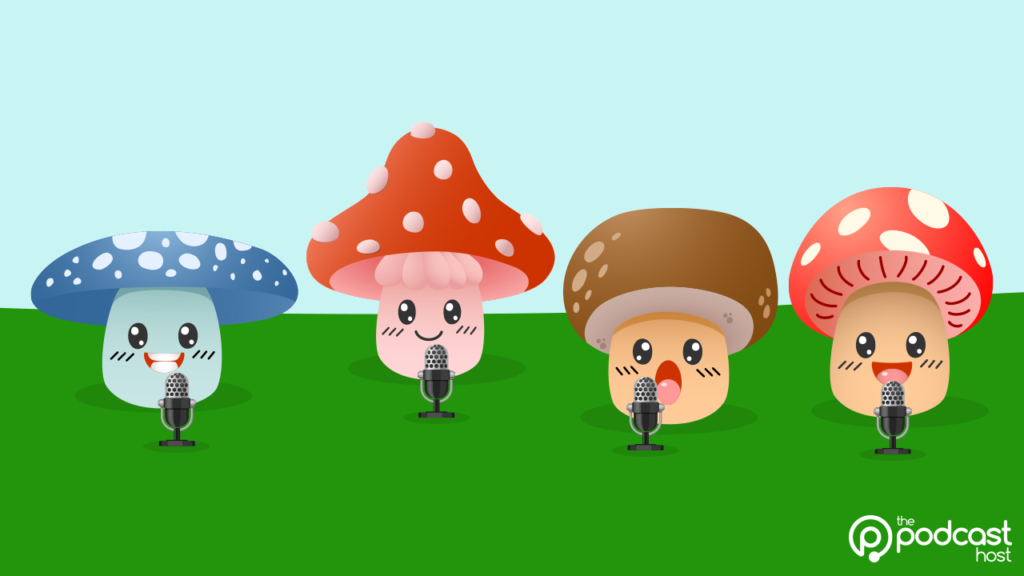
In simple terms, “fungible” means something that’s not unique. So it can be swapped for another of its kind really easily. Like a pound coin, or a 1 dollar note. They all mean the same thing, therefore they’re all worth the same thing.
So, if a token is NOT fungible, then it can’t be swapped. It’s unique. It’s one of a kind. That’s the key, that’s what gives it value.
NFTs are a way to make digital things unique and valuable. Most commonly, this “digital thing” is an image, such as a profile picture or a painting. But it could also be a video or an audio file. The NBA has been selling collectable video clips of their players in NFT form for a while now, and it’s gained real traction.
The other thing NFTs can do is to take unique, valuable things in the real world and store them in a digital way. An example of that is a ticket for a real physical event, made in NFT form.
Whatever the representation is on the web, there’s a bit of code behind that ‘picture’ or that ‘ticket’. It’s like a serial number, which makes it unique, un-copyable, one-of-a-kind.
So, you can copy the image, but you can’t copy the code behind it and own the original NFT. It’s like being able to print out a pic of the Monda Lisa and hang it on your wall, but that doesn’t mean the original isn’t still worth millions!
This one-of-a-kind original is created by logging every unique NFT on the blockchain.
Sheesh… the what-chain now?
Sidequest: What’s a Blockchain?
Even shorter story, a blockchain is a huge digital book that records the creation of NFTs and Crypto coins, and keeps a track of who owns each one.
There are zillions of different blockchains (exaggeration, but it feels like it!) and each one logs the coins and NFTs of its own type.
Between them all, they log every crypto coin and every NFT in the world. Bitcoin and Ethereum are two of the biggest in the world, and Solana is a fast growing one.
Every NFT can be a one-of-one, entirely one of a kind. Or it might be one ‘copy’ in a limited collection: 1 of 100, say. The 100 all look the same, but each of the 100 is still technically a unique copy, which can be tracked. Much like a limited print of an original painting.
So, at the end of the day, the reason an NFT has value (even though you can just copy the jpeg or the audio file willy-nilly) is that any given NFT is the original, and can only be owned by one person, no matter how many copies are taken of the media itself.
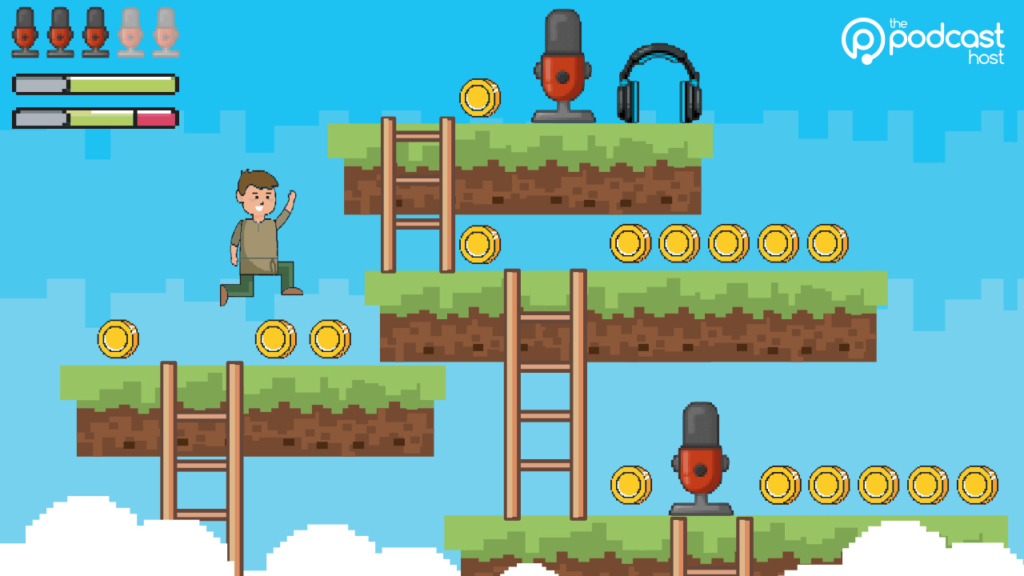
How Could NFTs be Used to Earn from Your Podcast?
There have always been ways to charge for your content. But, one of the perennial sticking points in digital content is the low perception of value. We all know how hard it is to encourage someone to pay for an ‘exclusive’ podcast episode. Especially when you’ve already got 100 others out there, in Apple Podcasts, for free.
Equally, when I buy access to your private feed, I know I’m not getting anything particularly exclusive. Dozens, or hundreds, or (you lucky dog!) thousands of people have probably bought the same thing and have copies on their listening device.
But, NFTs, and the blockchain they’re built on, could change that. Like I said above, the non-fungible part means that these things are unique. If someone buys one of your exclusive NFT episodes, then they really do own that one unique asset, and they can trade or sell it in future.
Imagine that. In the old digital world, you buy a film on Amazon. You buy an album on Apple Music. You buy a podcast episode on Memberful. And that’s it, you listen or watch, but you can’t do much else with it.
This could change all of that. Once you’re done listening, you can sell that NFT on the market, and let someone else enjoy it. Meanwhile, if that creator has done well, then the collector value of that NFT has gone up. So, you get to enjoy the asset, and then you make money on it in future! Even if not, at least you get second-hand value on it, a little money back, when you’re done.
How NFTs Could Make Your Audience a Partner in Your Success
This takes us to the part of the whole process which could be the biggest game-changer. The idea that your listeners become partners in your success, and motivated to help you succeed.
The listener, the one who bought your NFT, they’re not solely at the mercy of lady luck. Instead, they do have an element of control over how well your show does. To increase the value of the NFT, they could promote your work, in order to drive up demand for your content.
When someone buys your NFT, they essentially buy a share in your reputation. And, if they so choose, they could go all-in on your community. They might offer value to that community themselves, making it the best community out there, promoting what you do. If both you and they do their work well, then the value of your brand and your community rise, so more people join.
And if that happens, guess what? Yes, the value of your NFTs could rise too.
At the end of the day, that NFT-owning listener could be paid back in a range of ways. They could benefit from a great community, which they help to build. They could benefit from your great content, potentially improved and expanded by the financial support from your NFT sales. And finally, they might benefit by being able to sell that NFT whenever they choose, and make a profit on all the effort they put in.
In short, NFTs could incentivise buyers to help you grow your audience and reputation.
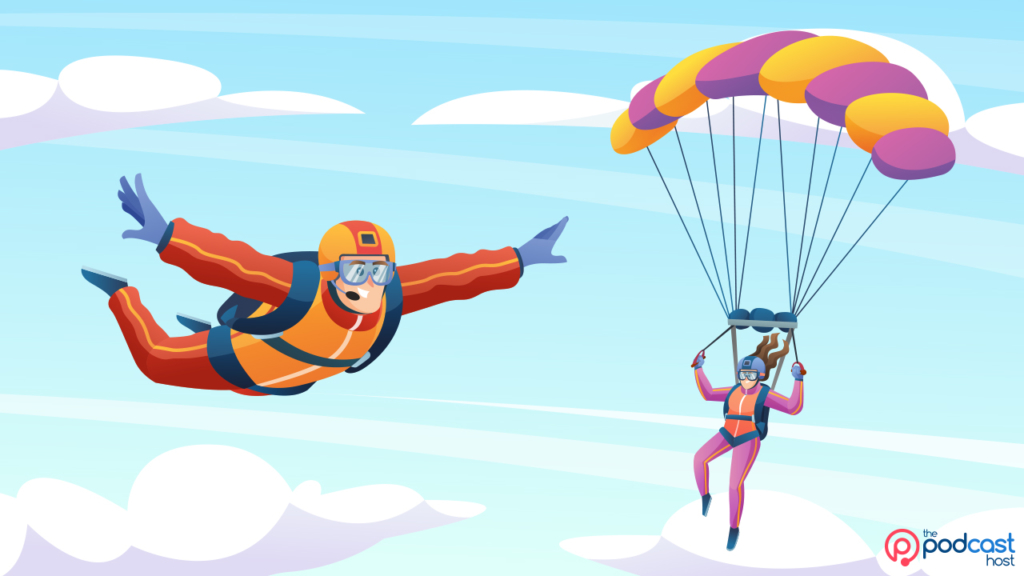
What are the Downsides and Risks in NFTs?
Bringing it back down to earth… I’ll be honest, all of the benefits of NFTs are still a very big “if”.
There are some huge issues around NFTs in their current form.
Their environment impact, security, accessibility, copyright and more.
But then, it’s early.
Soooo early.
Right now, it’s Orville and Wilbur testing out the first few models of their bed with wings.
Truthfully, I don’t think the average podcaster should get into this world right now.
The questions are too big, and the benefits too small, at this moment. I mean, would you get into the Wright brothers’ first aeroplane and launch it off a cliff…? It could fly… Likely it won’t!
But you, our readers, are asking about this, thinking about it, preparing.
And our mission is to help you guys to do everything and anything you want to related to your podcast.
So, that’s why I got interested, we started researching, creating and writing, so that we can help when the time’s right. That’s what this article is all about. I think there’s a chance that NFTs can be an amazing way to grow a community, to offer them so much and to earn from your content as a result.
If the blockchain community can figure out how to solve the existing issues, (and I think many are working on it) then it could get there. And I want this guide to be there to help you take part in that when it does.
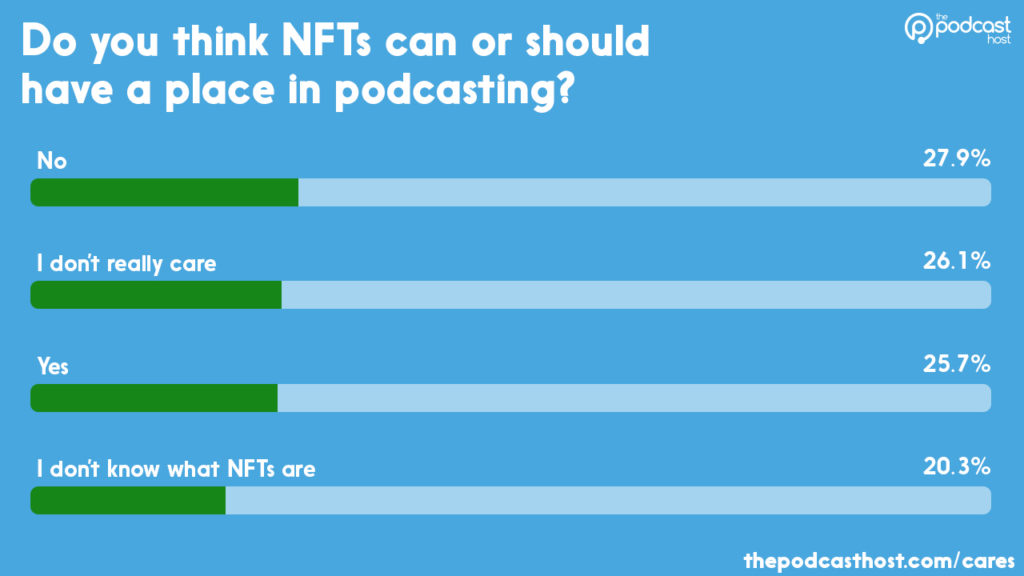
The List of Big NFT Issues…
Here we go, all the things you should be thinking about before you get into this. I go in-depth on these in our “Why are we interested in NFTs” article, so you can see further details there, including a lot of numbers around the environmental impact.
1. Environment Impact
Some blockchains, particular Ethereum, are huge energy consumers. My feeling is that it’s just not right to use these for NFTs.
Luckily, there are far more sustainable alternatives, such as Solana or Tezos which use a similar amount of energy as everything else you do on the web.
2. Social Equality
There’s a very legitimate argument against creating wonderful things which are gated, behind a paywall, only available to the rich. It goes both ways, though: artists should still be able to benefit from their work, and private sale has always been a part of the art world.
One solution is that NFTs should be created and published openly, so anyone in the world can view or listen to them. But true fans of the artist can still buy and own the original. This is possible on most big NFT marketplaces.
This keeps the content open to all, but allows the artist to support their work. It doesn’t solve everything, but it feels a better balance.
3. Security and Fraud
This is a big issue. The systems are improving every day, but it’s still so, so easy to lose money in Cryptocurrency through outright fraud or simple mistakes.
You can click the wrong button or type the wrong address and your money literally disappears into the ether, with absolutely zero chance of recovery.
There’s no regulation, no central management, and therefore the financial risks are severe.
4. IP and Ownership
Again, because of the lack of regulation, there have been many issues around legal ownership and control. There are numerous cases of NFTs being involved in IP theft or fraud.
Even when the IP is legit, there have been cases of uncertainty over whether you really own it, or whether the creator retains ownership.
Again, it’s early. The risks of spending a lot on an NFT and not getting quite what you thought you bought is still high.
Should You Get In Now?
So, clearly, there’s still uncertainty here. Not least how crazy-complex it still is to buy and hold cryptocurrency.
Those are many of the reasons I don’t necessarily recommend that podcasters get heavily into NFTs right now. But, there are people in the Crypto world working on the problems.
Both Tezos and Solana, to take just two examples, seem to be working sustainability and energy use heavily into their roadmap. That’s something that can’t necessarily be said for many of the existing services, social networks and websites that we use every day, without thinking.
So, if our team experiment more in this space, beyond our first test, it’ll be with one of the Blockchains that show they’re making this a priority. And, we’ll be careful to watch whether they stick to those claims. As always, we’ll do our utmost to then pass that on to you, so you can make your own decision.
How Do I Make Podcast NFTs?
Okay, you’ve looked at the risks, and you’re happy that you still want to explore this area, even just experimentally right now. So, how do you create one of these things?
Good question!
We’re not visual artists, after all, so how do we do this in audio?
At this stage, I can see two ways to go about this. The first is to stick with our existing content and approach, and create NFTs from that. This is the easiest starting point, and could have some great possibilities.
And the second is to think about generative audio, and how that could work for us as podcasters. This is an approach that really plays on the strengths of the NFT format, but it takes a fair bit more planning and work.
So, let’s look at both, but we’ll start with the existing content approach.
Podcast NFTs Using Our Existing Content Format
This is a simple way to start. Use audio you’ve already created, either entire episodes or shorter clips, or create one new recording which is minted on the blockchain.
1. Mint an existing notable episode
Take your episode 50 or episode 100, create a ‘special episode’ that stands out, and then mint 50 or 100 editions of it on the blockchain. Your listeners can buy these ‘collectors editions’ and own them forevermore.
2. Mint a new unique piece of content
Create something brand new, something you know will resonate with your listeners, and then launch it, with great fanfare as an NFT.
Again, you could mint a limited run of 100, or 500, or even 1000 or more. This won’t be on your standard podcast feed, so it carries a bit of extra cache, especially if you can create something a little different from your average episode.
So, that’s existing content. What about a new approach: generative audio? Let’s take a look!
Podcast NFTs Using Generative Audio
One of the most common approaches in NFT creation is called generative art, and I think this can apply in really cool, creative ways to audio.
Generative art is a pretty open term, but to me, it refers to any creative work that includes an element of randomisation, sometimes with the input of computer code, but not always.
In generative art, the artist creates a set of base elements, to begin with. Then, they use a computer and a bit of code, or just some old fashioned manual legwork, to generate art based on those original elements. The variations are all based on the original input, but will all be entirely unique.
So, you might have 100 results, or a thousand, and each one has variations and changes which make them different. The creator sets up the variables and then software combines them in all sorts of ways to ‘generate’ the variations. That’s where the word generative comes from.
This approach is what really caught the imagination of the world when NFTs first launched in the form of profile picture artwork (PFPs in NFT slang). The Crypto Punks were one of the first. Each image follows the same format but has different attributes. Some attributes are rarer than others, and keen collectors seek out their favourite features or combinations.
It’s clear that this works great in visual art. And, I think it can work just as well in audio.
I’m going to write up a full article on how to create these, with examples, and including an experiment we ran ourselves. I’ll update here with the link when it’s ready. But, in the meantime, here are a few ideas.
- The Thesaurus Method
AKA: Same Story, Different Words
Take one story script and create some variations of each line, but keep the meaning the same. - The Linear Substitution Method
AKA: Same story, different events
Take one linear story script, and create some variations which change the meaning of certain lines. This creates the possibility of unusual, ridiculous combinations, alongside the more creative ones that work. - The Branching Storyline Method
AKA: Different story, every time
Create a story with different branching routes. The variations tell lots of different pathways, but coverage again at the same ending. Think ‘choose your own adventure’ books, or Dynamic storyline games like Fable. - Community Generated Content
AKA: Don’t create it all yourself
Ask a few questions of your audience, and use their contributions as the variables. You could end up with 1000s of variations, drawing from many members of your audience.
NFTs for an Educational or Inspirational Podcast: Full Example
I’ve used stories a lot, above, because they’re easy to explain. But what if you’re a non-fiction podcast, teaching or inspiring or motivating through your content?
Well, let’s look at a fleshed-out example of how this might work for your context. After all, there’s a good chance you’re in this bucket, since it covers a vast swathe of shows out there, from knitting to marketing to fitness.
One way to create something unique and valuable, in this world, might be to create a collection of micro-courses in a generative fashion.
Take Podcraft, for example, our show on how to make a great podcast. We could create a ‘Grow your Show’ NFT collection based on the podcast.
How to Create Your Educational NFT
Let’s say we want it to contain 8 segments in total, like the Linear Substitution story above. Matthew and I might record three alternative introduction segments and 3 alternative outros. We have fun with it, adding in our catchphrases, in-jokes, and mentioning some active or loyal community members, etc. That makes those segments themselves collectable.
Then, we record 18 different growth tasks, taking them from our Podcast Growth Book. Relatively short, 2 or 3 minutes tasks, with instructions on what to do.
The end result is 18 + 6 = 24 total clips, just like the story above, which can be combined into 6561 possible micro-courses in the form of NFTs. Every NFT will have our intro and outro, plus 6 small tasks to complete, all designed to help our audience grow their show.
NFTs for Interview Podcasts: Full Example
So, the above example is easy enough with a solo or a co-hosted show. You have full control, in that case. But, what about an interview show? Well, again, we just need to get creative!
How can we create some variations that are valuable and interesting?
Here’s one idea:
- Pick out three people to interview. They might be past interviewees who were really popular, or new interviewees who your audience really want to hear.
- Design a set of short or quick-fire questions. The goal here is to end up with, say, 10 short questions and answers, each up to 3 minutes long.
- The end result is 10 questions, each with 3 answers (1 from each interviewee). That makes for 59,049 possible combinations!! If you add in a few unique intros and outros, as I did in the example above, that escalates fast, and ends up around half a million 🤯
- Combine those answers into a small set of unique NFTs. In the end, no single NFT will contain the same sequence of answers, and so you’ll be able to sell 100, or 500, or 1000 (or more!) combinations, all of which offer their own unique and valuable advice.
Again, you can add any or all of the features and utilities I discussed above in the educational example.
What Are the Benefits to Your Audience?
This is the important part! How can you use NFTs to help your audience more? That might mean offering more value, more engagement or more fun! This is the key to figuring out why your audience might buy one, and how you help them stay valuable in future.
Here are some of the common selling points for an NFT, or real utility that you can build in to offer more value. You should go ahead and create your own combination of benefits that fits your audience best. I’ve used our Podcraft example from the section above to give examples.
1. Purchase to Support the Show: Donation/Patreon
First, we’d release this and promote it as a method of supporting our show. In this sense, it’s much like a donation, or a Patreon, where we give them a little something in return for a payment. So, we encourage our audience to buy one and complete the micro-course.
2. Get a Genuinely Unique & Saleable Asset
The first benefit of NFTs over donations is that each of these are unique, so every buyer is getting a different combination of tasks to try out. That means the reward they get for buying carries more value and novelty than a standard piece of premium content.
Secondly, your audience owns the NFT and can sell it again in future, if they choose to.
3. Collect Them All and Try Them Out
Next, we get to collectability. We could encourage our community to buy their first one and try it out. Then, they could start collecting others to continue promoting their show.
Your audience can own as many of these as they like, of course!
4. Community Involvement to Grow Value
You can build on the collectability by running polls on which NFTs (and the task combos within) get the best results. Your audience can even swap them with each other so that it’s possible to own the NFT as you test it out.
Equally, you can also build more community spirit by allowing holders to vote on their favourites, whether that means the funniest, the most useful, or the most ridiculous variations amongst the collection.
5. Restrict Access to NFT holders
This is a decision you’ll have to make: will the NFTs and community be completely open? Or will it all be restricted to NFT holders?
The latter is possible. You can develop NFTs so that they allow access to a community (eg. a space on Discord), and only holders can hear their own audio. Or, perhaps holders can hear the entire collection. You can imagine a tonne of possibilities here, and your first instinct might be to hold them back, behind closed doors. It could be a good instinct, too.
But, many NFT collections have also flourished by being entirely open. That openness can cause the reputation of the collection to grow, and the collectability and value alongside. It means holders can show off what they hold, and allows anyone to see what they could buy.
To restrict access, you’ll need a developer’s help. Although more user-friendly tools are coming out all the time.
6. Offer Votes into NFT Direction, based on Ownership
Building on the restrictions above, another feature you can offer holders is the ability to vote on future directions. Because this is restricted to owners, it feels exclusive, special. Allow your audience to tell you what they want next, and airdrop them more content based on that. This grows the value for your holders (free stuff which they can use and/or sell!) and increases loyalty as you give them more and more for their initial investment.
7. NFTs Evolve over time as Holders Try out the Tactics
A ‘next level’ on this might be to allow the NFTs themselves to ‘evolve’. This, again, would take a bit of developer time, but let’s explore it.
Imagine if your users could buy an NFT and start working their way through the task checklist contained within.
On completion, the user applies for verification that they really have completed the checklist. The verification itself could potentially be done in code, automatically checked by the smart contract that defines the NFT (“copy in your twitter promotion URL here”). Or, it could be done by an admin, a community moderator, or a community vote.
However it’s completed, once that verification is done, the NFT ‘levels up’ and records who completed it. Perhaps it even records some results (“number of retweets you earned”). The NFT can change as a result: either the graphic could show it’s been ‘completed X times’ or a short recording is added to the audio, where we congratulate the person or encourage them to keep going in some way.
Perhaps you save some special congratulation recordings, or extra ‘pro’ tips for NFTs which have 100 completions, or 1000!
At this level, you can do just about anything that could be programmed into a few “if this happens, then do that”. The possibilities are sky high!
Frequently Asked Questions
Okay, this is a really new space, so there are plenty of FAQs! I’ll start with a few here, and add in more as I hear them!
Are the NFTs All Public to Hear?
It’s possible to go a few ways with this in terms of privacy, too. You can keep the NFTs closed, only accessible if you own them
The benefit of that latter is that it could be possible to ‘evolve’ or grow the NFT by verifying that you completed the checklist.
Add in some utility to allow access to a private support group, if you own one.
How Do You Create or Asses Rarity in Audio NFTS?
Rarity refers to the idea that some attributes (or combination of attributes) are rarer than others because they appear less often in a collection.
For example, in profile pic collections like the original Crypto Punks, or newer ones on Solana like the Degen Ape Academy, you might have a hat that appears on only a few characters in the entire collection. Or you might have a combo of three things – a particular hat, with a unique earring and a certain background – which are one of a kind.
That combo might make your particular image #1 in terms of rarity. If you pull that off, then you’ve hit it big! Your NFT will most likely be the most valuable of the bunch.
In audio, it might be that you include one particular clip in just a few of your NFTs, so that clip makes those NFTs very rare. Or, it might be a combination of clips, one after the other, that brings rarity value.
In our tester collection – the Curious Companion – there are three ‘true’ storylines, which could be considered rare. As a result, there are only three individual results, from 6000+ possible combinations, that contain clips from only one column. That means those three, and those three alone, tell one of the linear stories, as they were written. Does that make them rare? Or does it make them the most boring? That’s something we can’t really tell up front. Instead, it’ll be decided by the buyers and those that enjoy the collection. They’ll vote with their purchases, and which ones they choose to collect. That’s all part of the fun!
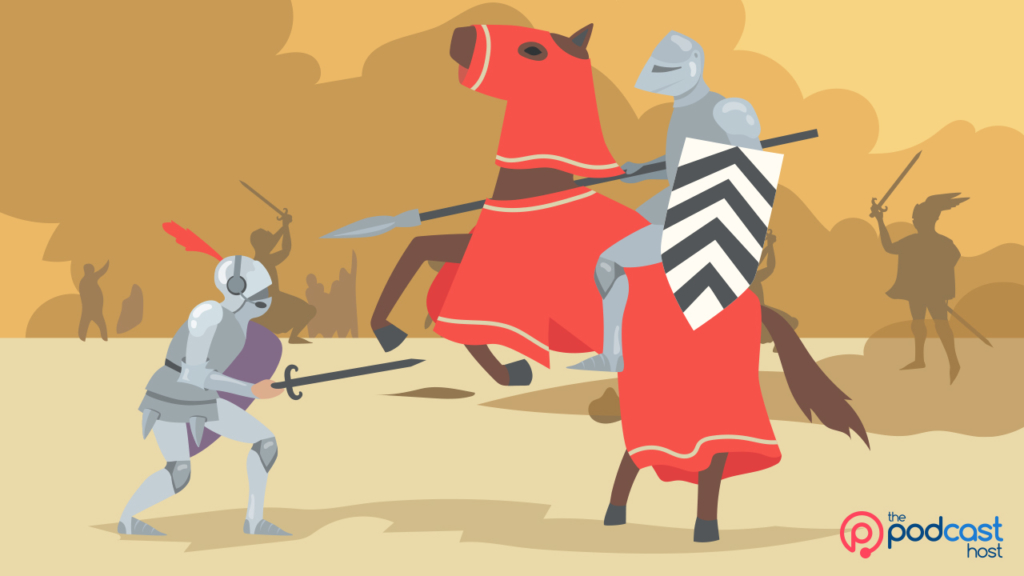
What if I Don’t Tell Stories?
How does this apply to the average conversational podcast? I hope I’ve given you some ideas in the examples above, for both educational and interview shows. But, here are a few more ideas.
I’d suggest that if you co-host your show, you can script out a chat between the two of you, and treat it like a story, even though it’s about real life. If you follow that approach, all of the generative techniques above could work for you.
Remember, a lot of the value here is in how creative you can get. Tie it into the personality of your show. What are the in-jokes? The standard ‘bits’? How can you create a short ‘skit’ that does some audience service, making them laugh, offering a bit of value, inspiring them?
Here are some ideas:
- Record 20 ‘tips’/clips/outtakes and combine them in all sorts of orders
- Use your in-jokes – record a short conversation and substitute in different ‘standard’ responses for each of you. Do you have any catchphrases to record and sub in? Any standard rants, soapboxes, or obsessions that you know will make the audience smile?
What’s This about Creating your own Coins, too?
Yea, that’s a whole different subject! Not to be covered here 😅
One of the worlds potentially worth exploring (with care for the risks!) is Rally coin. They help creators build an economy around their content. Check out prolific podcaster Brian Fanzo, and how he’s using his very own ADHD coin.
Is Cryptocurrency and Buying NFTs Safe?
Covered above already, but frankly, not really! You do need to be really, really careful.
Bear in mind that Crypto, wallets and NFTs are still the wild, wild west out there. It’s so early, still, that it’s really quite easy to lose your money.
Yes, all of it. Forever. And there’s no one to go to to get it back!
Lose your wallet keys and your money’s gone.
Send it to the wrong wallet and your money’s gone.
Accidentally visit the wrong site when your wallet’s open, and your money’s gone.
I’ve been pretty careful and done a lot of research, but I’ve still lost money (and not a little…) to scams, mistakes and simply bad projects over the past year.
Do your research. Only play with money you can afford to lose. And read as many guides as you can on staying safe in the world of Crypto.
How Do You Actually Buy an NFT?
The basic principle is like this: set up a crypto wallet, buy some crypto, and then buy the NFT! Simple, eh?
Eh, nope 😆
It’s getting easier every day, but the world of Crypto is still weird, alien and complex.
I’m no expert on Blockchain or wallet tech, so can’t recommend any particular approach here. Instead, I’m going to defer to an excellent guide by the Dronies team. You’ll find it right here:
How to set up a Solana Crypto wallet.
Again, referring to the ‘is it safe’ question above, please, please, do your research, and be careful every time you connect your wallet. Only spend money you can afford to lose. I’m just telling you this for information purposes, it’s not financial advice.
What’s Next in Audio NFTs?
I hope you’ll find this a balanced guide to the world of NFTs, and the world of Web3 in general.
I have no doubt it’s too early for the vast majority. Too many problems and risks remain. But, there are always early adopters, and we’re here for you as much as the wider podcasting world.
If this has given you an insight into the many possibilities in the space, balanced with the downsides, then I’ll have done my job! The possibilities are just crazy-vast, but only if the Crypto world can overcome the big hurdles in its way.
